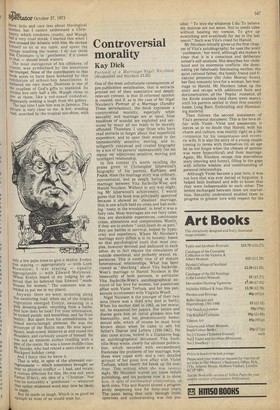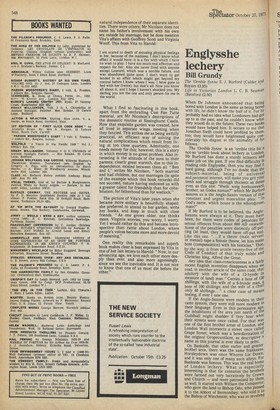Controversial morality
Kay Dick
Portrait of a Marriage, Nigel Nicolson (Weidenfeld and Nicolson £3.25)
One of the most unfortunate consequences of pre-publication serialisation, that is extracts printed out of their associative and deeply relevant context, is that ill-informed opinion is created, and if, as in the case of Mr Nigel' Nicolson's Portrait of a Marriage (Sunday Times serialisation), thern book expresses a controversial morality, especially when sexuality and marriage are at issue, false headlines of scandal are exploited and savoured by many all too ready to be morally offended. Therefore, I urge those who have read extracts to forget about that superficial experience, and to open their minds to the immeasurably sensitive, moving, and intelligently conceived and created biography by a son of his parents' immeasurably (let me repeat my adjectives) sensitive, moving and intelligent relationship.
In this context it's worth recalling the praise given to Christopher Isherwood's biography of, his parents, Kathleen and Frank. Here the marriage story was ordinary, conventional, and as deeply loving as the marriage between Vita Sackville-West and Harold Nicolson. Without in any way slighting Mr Isherwood's achievement, I would guess that his book was principally approved because it showed an ' idealised ' marriage, that is one which held no crisis and had nothing nasty in the woodshed,' in brief it was a fairy tale. Most marriages are not fairy tales, they are shockable experiences, continuous crises, alienations and compromises. Mostly, if they are to endure " until death do us part," they are battles in survival, helped by hypocrisy and expediency. Where Mr Nicolson's marriage story differs is in its honesty, based on that psychological truth that most couples, however devoted and dedicated to each other, do in fact require the stimulation of outside emotional, and probably sexual, experiences. This is surely true of all mature heterosexual relationships. What has been viewed as ' shocking' about Vita SackvilleWest's marriage to Harold Nicolson is the bisexuality of both partners, in particular Vita Sackville-West's autobiographical account of her love for women, her passionate affair with Violet Trefusis, and her less passionate involvement with Virginia Woolf.
Nigel Nicolson is the younger of their two sons (there was a third who died at birth). When his mother died in 1962, as her executor, he examined her papers. Her letters and diaries gave him an initial glimpse into her bisexuality, and her predominantly homosexual side, which of course he must have known about when he came to edit his father's Diaries and Letters (1930-1962). He also came across, locked in a Gladstone bag, an autobiographical document Vita Sackville-West wrote, clearly for ultimate publication, which recorded with extraordinary frankness the problems of her marriage, how these were coped with, and a very detailed account of her great love affair with Violet Trefusis, which nearly did break up the marriage. This written when she was twentyeight. Mr Nicolson waited ten years before publishing, and his purpose now is to show, how, in spite of extramarital relationships. on both sides, Vita and Harold shared a progressively deepening love for forty-nine years. The point being that only through truth, openness and understanding was this pos
sible: "To love me whatever I do. To believe my motives are not mean. Not to credit tales without hearing my version. To give up everything and everybody for me in the last resort." Such was Vita's creed for Harold.
Mr Nicolson initially gives us the first chapter of Vita's autobiography; he uses the word 'confession,' her word, although she makes it clear that it is a conscious and deliberate writer's self-analysis. She describes her childhood and its enormous conflicts: the dominating yet fabulously fascinating mother, the quiet rational father, the family friend and financial protector (Sir John Murray Scott), her first romantic love for a woman, her marriage to Harold. Mr Nicolson takes up the story and recaps with additional facts and documentation; all the ' Pepita ' romance, all the Knole scandals (and there were many), until his parents settled in their first country home, Long Barn. Enthralling and illuminating material.
Then follows the second instalment of Vita's personal document. This is the love affair with Violet. Vivid and passionate, it leaves us in no doubt that Harold, with his charm and culture, was exactly right as a life companion for his tempestuous and eccentric wife. It is also the story of a young couple coming to terms with themselves (in an age let us not forget when the climate of opinion was more hypocritical) and their marriage. Again, Mr Nicolson recaps this marvellous story (moving and funny), filling in the gaps with infinite wisdom and understanding of personal relationships.
Although Violet became a past love, it was not love that was ever denied or forgotten: it helped both husband and wife to know that they were indispensable to each other. The letters exchanged between them are marvel lous. Sexuality understood enabled them to progress to greater love with respect for the natural independence of their separate identities. There were others; Mr Nicolson does not name his father's involvement with his own sex outside his marriage, but he does mention Vita's affairs with Geoffrey Scott and Virginia Woolf. This from Vita to Harold:
I am scared to death of arousing physical feelings in her, because of the madness. I don't know what effect it would have: it is a fire with which I have no wish to play. I have too much real affection and respect for her. Also she never lived with anyone except Leonard, which was a terrible failure, and was abandoned quite soon. I don't want to get landed in an affair which might get beyond my control before I knew where I was. I have gone to bed with her (twice), but that's all. Now you know all about it, and I hope I haven't shocked you. My darling you are the one and only person for me in the world.
What I find so fascinating in this book, apart from the enthralling Cosi Fan Tutte material, are Mr Nicolson's descriptions of the domestic routine at Sissinghurst Castle. How that exquisite garden was created, how all lived in separate wings, meeting when they fancied. This strikes me as being awfully practical, an efficient way of solving the natural complications which result from living at too close quarters. Admittedly, one needs money for this; however, this is a story in which money is no great problem. Also interesting is the attitude of the sons to their parents; clearly great warmth, due to this independence, existed between them all. "Ben and I," writes Mr Nicolson, "both married and had children, but our marriages (in spite of the example which this book records) did not succeed, nature having endowed us with a greater talent for friendship than for cohabitation, for fatherhood than for wedlock."
The picture of Vita's later years when she became more solitary is beautifully shaped: she preferred to attend to her garden, write her books, and keep in touch with close friends. "As one grows older, one thinks more. Virginia worries, you worry, I worry. Yet I would rather do this and become introspective than rattle about London, where people's voices become more and more devoid of meaning."
One reality this remarkable and superb book makes clear is best expressed by Vita in one of her last letters to Harold: "Now, in our advancing age, we love each other more deeply than ever, and also more agonisingly, since we see the inevitable end. It is not nice to know that one of us must die before the other."



































 Previous page
Previous page